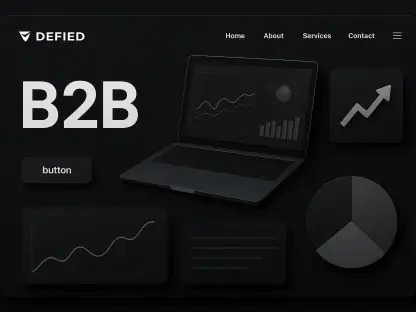The Landscape of Digital Advertising Today
Imagine a global market where nearly $700 billion changes hands annually, shaping how billions of internet users interact with content every day, and driving the internet economy by monetizing everything from news articles to social media posts. This colossal figure represents the digital advertising industry, a powerhouse with undeniable scale and influence, as businesses and creators rely on ad revenue to sustain operations in an increasingly digital world. This ecosystem not only funds free content but also dictates how information is prioritized and delivered across platforms.
At the heart of this industry lie distinct segments such as display advertising, which includes banners and videos, search advertising tied to user queries, and programmatic buying through real-time bidding. These mechanisms allow ads to be placed instantly based on data-driven decisions, transforming how brands reach audiences. Technologies like ad exchanges, demand-side platforms for buyers, and supply-side platforms for publishers have automated much of the process, enhancing efficiency while raising questions about transparency and control.
Key players dominate this space, with Google holding a commanding position alongside competitors like Meta and Amazon, while smaller ad tech firms struggle to carve out market share. Google’s influence spans multiple layers of the ad ecosystem, often overshadowing other participants. Meanwhile, regulatory scrutiny is intensifying, with antitrust actions and legal challenges targeting major players to ensure fair competition. These dynamics underscore a complex environment where innovation, market power, and oversight collide, setting the stage for a deeper examination of industry practices.
Google’s Path to Dominance in Ad Tech
Strategies of Acquisition and Integration
Google’s ascent in digital advertising began with calculated moves to acquire pivotal technologies that would anchor its empire. The purchase of DoubleClick for $3.1 billion in 2008 marked a turning point, providing a robust platform for display ads and publisher tools. This was followed by the acquisition of Admeld in 2011 for $400 million, further strengthening its capabilities in optimizing ad inventory for publishers and advertisers alike.
These acquisitions were not merely financial transactions but strategic steps toward vertical integration. By merging these platforms into a cohesive ad tech stack, Google gained control over critical touchpoints, from ad creation to delivery and measurement. This allowed seamless interaction between advertisers seeking impressions and publishers offering space, consolidating power in a way that few competitors could replicate.
The technological edge gained through integration translated into market advantages, enabling Google to offer end-to-end solutions that streamlined operations for clients. Publishers and advertisers found themselves increasingly reliant on a single provider for tools that once required multiple vendors. Such dominance, while efficient, raised concerns about dependency and the stifling of alternative innovations in the sector.
Market Control and Performance Metrics
Current data reveals Google’s staggering grip on the market, with a 91% share in publisher ad servers and substantial influence over ad exchanges like AdX. This level of control allows the company to dictate terms in ways that impact both pricing and access to inventory. Supracompetitive fees have become a point of contention, as they elevate costs for advertisers while squeezing revenue streams for publishers.
The ripple effects of this dominance are evident in performance metrics, where higher fees often mean reduced earnings for content creators who depend on ad income. This imbalance has sparked debates about fairness in revenue distribution and whether such market power undermines the sustainability of independent publishers. Smaller players, unable to compete with these margins, frequently find themselves marginalized.
Looking ahead from this year to 2027, Google’s entrenched position could further shape market dynamics, especially if legal challenges alter its operational scope. Trends suggest that without intervention, concentration may deepen, potentially stifling emerging competitors. However, regulatory outcomes could introduce shifts, fostering opportunities for diversification if structural changes are enforced.
Tactics of Monopoly: Manipulation and Exclusion
Concerns about Google’s practices extend beyond market share to specific strategies that allegedly undermine competition. Internal programs, codenamed Bernanke and Poirot, have come under scrutiny for manipulating ad auction dynamics to favor Google’s own platforms. Such actions, often hidden from industry partners, suggest a deliberate effort to prioritize profit over equitable dealings.
Further tactics, including First Look, Last Look, and Unified Pricing Rules, have been criticized for restricting publisher choices and sidelining rival ad tech providers. These mechanisms reportedly gave Google preferential access to inventory or pricing advantages, limiting the ability of others to compete on equal footing. The result has been a constrained marketplace where options for advertisers and publishers are curtailed.
This dual role as both intermediary and competitor poses ethical challenges, creating inherent conflicts of interest. When a single entity represents both buyers and sellers while participating in the market itself, trust erodes among stakeholders. Addressing these issues may require greater transparency in auction processes or robust regulatory measures to ensure fairness, offering a path toward balancing power in the industry.
The Legal Battle Against Google’s Ad Tech Practices
The regulatory landscape surrounding digital advertising has grown increasingly contentious, with significant antitrust litigation targeting Google’s practices. A landmark ruling earlier this year by Judge Leonie Brinkema in the Eastern District of Virginia found Google guilty of violating Sections 1 and 2 of the Sherman Act. This decision highlighted illegal monopolistic behavior in key advertising markets, marking a critical juncture in oversight of tech giants.
Court findings detailed how Google’s actions systematically disadvantaged competitors through exclusionary tactics, affirming long-standing industry grievances. The ongoing remedies phase, led by the Department of Justice, pushes for divestiture of major ad tech assets, a move that could fundamentally alter the company’s structure. Such measures aim to dismantle concentrations of power that have hindered competitive growth for years.
Beyond this case, heightened federal enforcement signals a broader shift in how Big Tech is regulated. This wave of action influences industry practices by setting precedents for accountability and encouraging smaller firms to challenge dominant players. As legal frameworks evolve, they could redefine competitive dynamics, potentially fostering a more diverse ecosystem for digital advertising in the coming years.
The Future of Digital Advertising Amidst Google’s Monopoly
As the industry navigates Google’s overwhelming presence, the trajectory of digital advertising hinges on multiple evolving factors. Legal challenges may force structural changes, but emerging technologies also hold promise as potential disruptors. Alternative ad tech platforms and privacy-focused models are gaining traction, offering solutions that prioritize user consent and data protection over traditional targeting methods.
Shifting consumer preferences add another layer of complexity, with growing engagement on social media and mobile apps reshaping ad spend. These platforms often bypass conventional web advertising, redirecting budgets away from spaces where Google holds sway. This trend challenges the status quo, pushing advertisers to explore new channels that may dilute the impact of any single provider’s dominance.
Innovation, regulatory outcomes, and global economic conditions will collectively define the sector’s path forward. Advances in ad tech could introduce efficiencies that benefit smaller players, while legal rulings might open doors for competition. Economic fluctuations, meanwhile, could influence advertising budgets, testing the resilience of current market leaders and creating openings for agile newcomers to gain ground.
Conclusion: Balancing Innovation and Accountability
Reflecting on the extensive analysis, it becomes clear that Google’s journey in ad tech is marked by strategic acquisitions, questionable tactics, and legal validations of monopolistic behavior. The examination of market control, exclusionary practices, and regulatory battles paints a picture of an industry grappling with concentrated power. These findings underscore a narrative of innovation intertwined with overreach, where efficiency often comes at the expense of fair competition.
Moving forward, actionable steps emerge as essential for stakeholders. Policymakers are urged to pursue structural remedies like divestitures to dismantle barriers to entry, while industry players need to seize competitive opportunities through innovation in privacy-centric models. Collaborative efforts to enhance transparency in ad auctions also stand out as a practical solution to rebuild trust among advertisers and publishers.
Ultimately, the path toward a balanced digital advertising ecosystem demands a blend of vigilance and adaptability. Encouraging technological advancements that empower smaller entities, alongside sustained regulatory pressure, offers hope for leveling the playing field. These considerations point to a future where accountability can coexist with progress, ensuring that the internet economy thrives on diversity rather than dominance.









